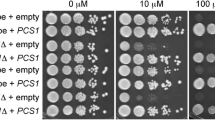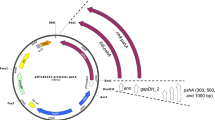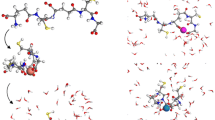Abstract
Metal-binding domains consisting of short, contiguous stretches of amino acids are found in many proteins mediating the transport, buffering, trafficking or detoxification of metal ions. Phytochelatin synthases are metal-activated enzymes that function in the detoxification of Cd2+ and other toxic metal and metalloid ions. In order to localize Cd2+-binding sites, peptide libraries of two diverse phytochelatin synthases were synthesized and incubated with 109Cd2+. Distinct binding sites and binding motifs could be localized based on the patterns of Cd2+-binding. The number of binding sites was consistent with previous findings for recombinant protein. Positions of binding sites appeared to be conserved even among diverse phytochelatin synthases. Mutant peptide analysis was used to assess the contribution of exemplary amino acids to binding. Several binding motifs contain cysteines or glutamates. For cysteines a strong correlation was found between binding activity and degree of conservation among known phytochelatin synthases. These findings indicate the suitability of peptide scanning for the identification of metal-binding sites. The functional role of several cysteines was investigated by expression of hemagglutinin-tagged phytochelatin synthases in phytochelatin synthase-deficient, Cd2+-hypersensitive Schizosaccharomyces pombe cells. The data are consistent with a model suggesting functionally essential metal-binding activation sites in the N-terminal catalytic part of phytochelatin synthases and additional binding sites at the C-terminus not essential for activity.







Similar content being viewed by others
Abbreviations
- EMM:
-
Edinburgh's minimal medium
- GSH:
-
glutathione
- HA:
-
hemagglutinin
- PC:
-
phytochelatin
- PCS:
-
phytochelatin synthase
References
Ausubel FM (1987) Current protocols in molecular biology. Greene Pub. Associates and Wiley-Interscience, New York
Bähler J, Wu J-Q, Longtine MS, Shah NG, McKenzie A III, Steever AS, Wach A, Philippsen P, Pringle JR (1998) Heterologous modules for efficient and versatile PCR-based gene targeting in Schizosaccharomyces pombe. Yeast 14:943–951
Beck A, Lendzian K, Oven M, Christmann A, Grill E (2003) Phytochelatin synthase catalyzes key step in turnover of glutathione conjugates. Phytochemistry 62:423–431
Clarke ND, Berg JM (1998) Zinc fingers in Caenorhabditis elegans: finding families and probing pathways. Science 282:2018–22
Clemens S, Kim EJ, Neumann D, Schroeder JI (1999) Tolerance to toxic metals by a gene family of phytochelatin synthases from plants and yeast. EMBO J 18:3325–3333
Cobbett C, Goldsbrough P (2002) Phytochelatins and metallothioneins: roles in metal detoxification and homeostasis. Annu Rev Plant Physiol Plant Mol Biol 53:159–182
Cobbett CS (2000) Phytochelatin biosynthesis and function in heavy-metal detoxification. Curr Opin Plant Biol 3:211–216
Frank R (1992) Spot synthesis: an easy technique for the positionally addressable, parallel chemical synthesis on a membrane support. Tetrahedron 48:9217–9232
Frausto da Silva JJR, Williams RJP (2001) The biological chemistry of the elements, edn 2. Oxford University Press, New York
Grill E, Löffler S, Winnacker E-L, Zenk MH (1989) Phytochelatins, the heavy-metal-binding peptides of plants, are synthesized from glutathione by a specific gamma-glutamylcysteine dipeptidyl transpeptidase (phytochelatin synthase). Proc Natl Acad Sci USA 86:6838–6842
Guerinot ML, Eide D (1999) Zeroing in on zinc uptake in yeast and plants. Curr Opin Plant Biol 2:244–249
Ha SB, Smith AP, Howden R, Dietrich WM, Bugg S, O'Connell MJ, Goldsbrough PB, Cobbett CS (1999) Phytochelatin synthase genes from Arabidopsis and the yeast Schizosaccharomyces pombe. Plant Cell 11:1153–1163
Himelblau E, Mira H, Lin SJ, Culotta VC, Penarrubia L, Amasino RM (1998) Identification of a functional homolog of the yeast copper homeostasis gene ATX1 from Arabidopsis. Plant Physiol 117:1227–1234
Hirayama T, Kieber JJ, Hirayama N, Kogan M, Guzman P, Nourizadeh S, Alonso JM, Dailey WP, Dancis A, Ecker JR (1999) RESPONSIVE-TO-ANTAGONIST1, a Menkes/Wilson disease-related copper transporter, is required for ethylene signaling in Arabidopsis. Cell 97:383–393
Huffman DL, O'Halloran TV (2001) Function, structure, and mechanism of intracellular copper trafficking proteins. Annu Rev Biochem 70:677–701
Kojima Y, Binz P-A, Kägi JH (1999) Nomenclature of metallothionein: proposal for a revision. In: Klaassen C (ed) Metallothionein IV. Birkhäuser, Basel, pp 7–13
Kramer A, Schneider-Mergener J (1998) Synthesis and screening of peptide libraries on continuous cellulose membrane supports. Methods Mol Biol 87:25–39
Kramer A, Schuster A, Reineke U, Malin R, Volkmer-Engert R, Landgraf C, Schneider-Mergener J (1994) Combinatorial cellulose-bound peptide libraries: screening tool for the identification of peptides that bind ligands with predefined specificity. Methods (Comp Methods Enzymol) 6:388–395
Lehmann S (2002) Metal ions and prion diseases. Curr Opin Chem Biol 6:187–192
Löffler S, Hochberger A, Grill E, Winnacker E-L, Zenk MH (1989) Termination of the phytochelatin synthase reaction through sequestration of heavy metals by the reaction product. FEBS Lett 258:42–46
Moreno S, Klar A, Nurse P (1991) Molecular genetic analysis of fission yeast Schizosaccharomyces pombe. Methods Enzymol 194:795–823
Outten C, O'Halloran T (2001) Femtomolar sensitivity of metalloregulatory proteins controlling zinc homeostasis. Science 292:2488–2492
Oven M, Page JE, Zenk MH, Kutchan TM (2002) Molecular characterization of the homo-phytochelatin synthase of soybean Glycine max: relation to phytochelatin synthase. J Biol Chem 277:4747–4754
Paulsen IT, Saier MH Jr (1997) A novel family of ubiquitous heavy metal ion transport proteins. J Membr Biol 156:99–103
Rae TD, Schmidt PJ, Pufahl RA, Culotta VC, O'Halloran TV (1999) Undetectable intracellular free copper: the requirement of a copper chaperone for superoxide dismutase. Science 284:805–808
Sneller FE, van Heerwaarden LM, Koevoets PL, Vooijs R, Schat H, Verkleij JA (2000) Derivatization of phytochelatins from Silene vulgaris, induced upon exposure to arsenate and cadmium: comparison of derivatization with Ellman's reagent and monobromobimane. J Agric Food Chem 48:4014–4019
Solioz M, Vulpe C (1996) CPx-type ATPases: a class of P-type ATPases that pump heavy metals. Trends Biochem Sci 21:237–241
Thompson JD, Higgins DG, Gibson TJ (1994) CLUSTAL W: improving the sensitivity of progressive multiple sequence alignment through sequence weighting, position-specific gap penalties and weight matrix choice. Nucleic Acids Res 22:4673–4680
Vatamaniuk O, Mari S, Lu Y, Rea P (1999) AtPCS1, a phytochelatin synthase from Arabidopsis: isolation and in vitro reconstitution. Proc Natl Acad Sci USA 96:7110–7115
Vatamaniuk O, Mari S, Lu Y, Rea P (2000) Mechanism of heavy metal ion activation of phytochelatin (PC) synthase. Blocked thiols are sufficient for PC synthase-catalyzed transpeptidation of glutathione and related thiol peptides. J Biol Chem 275:31451–31459
Zenk MH (1996) Heavy metal detoxification in higher plants — a review. Gene 179:21–30
Acknowledgements
Initial cysteine mutagenesis and analyses in yeast were conducted in the laboratory of Julian Schroeder (University of California San Diego) and were supported by NIEHS Superfund grant 1 P42 ES10337 to J.S., whom we thank for his support and comments on the manuscript. We thank Marina Häußler for expert technical assistance and Regina Weiss for sequencing. This work was supported by grants from the Deutsche Forschungsgemeinschaft (Sonderforschungsbereich 363) and the EU (QLK3-CT-2000-00479).
Author information
Authors and Affiliations
Corresponding author
Rights and permissions
About this article
Cite this article
Maier, T., Yu, C., Küllertz, G. et al. Localization and functional characterization of metal-binding sites in phytochelatin synthases. Planta 218, 300–308 (2003). https://doi.org/10.1007/s00425-003-1091-7
Received:
Accepted:
Published:
Issue Date:
DOI: https://doi.org/10.1007/s00425-003-1091-7




